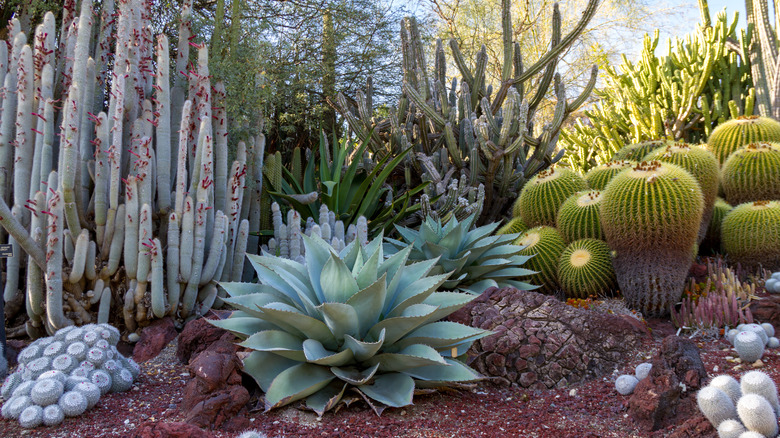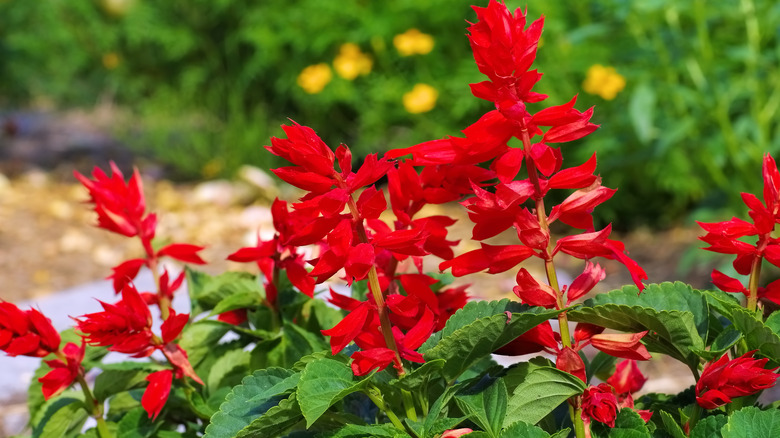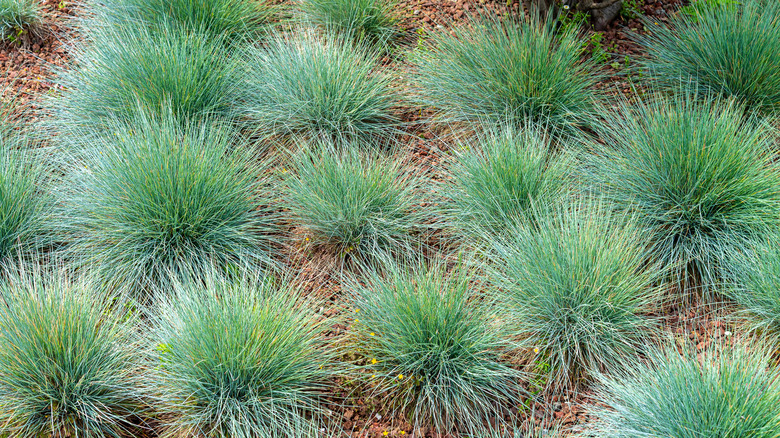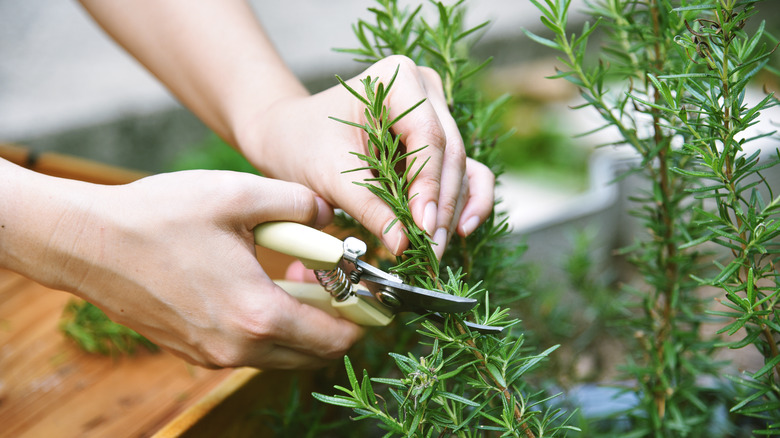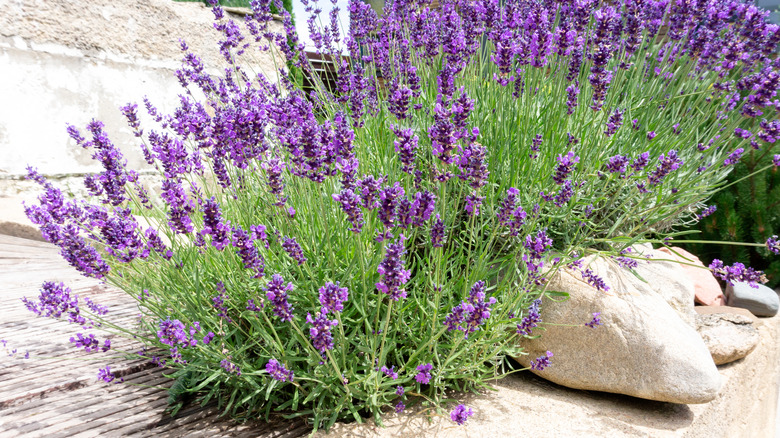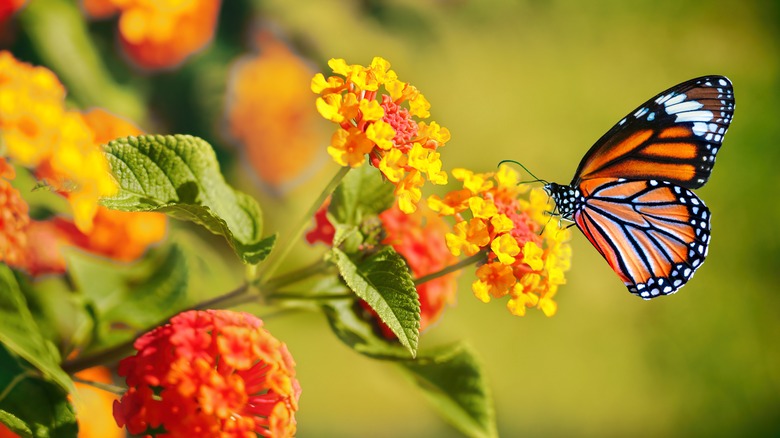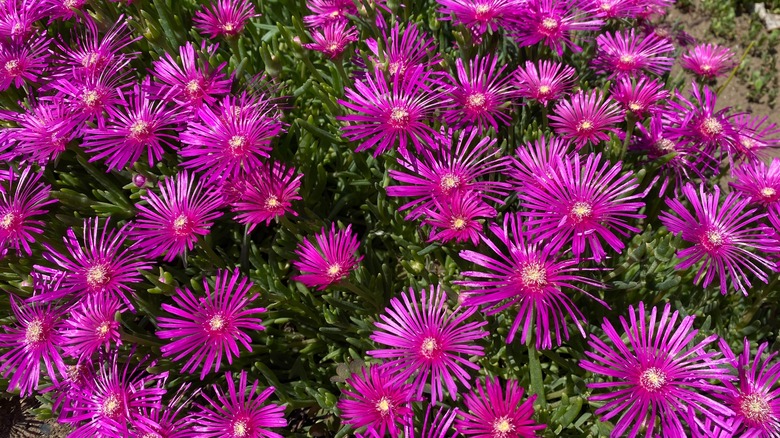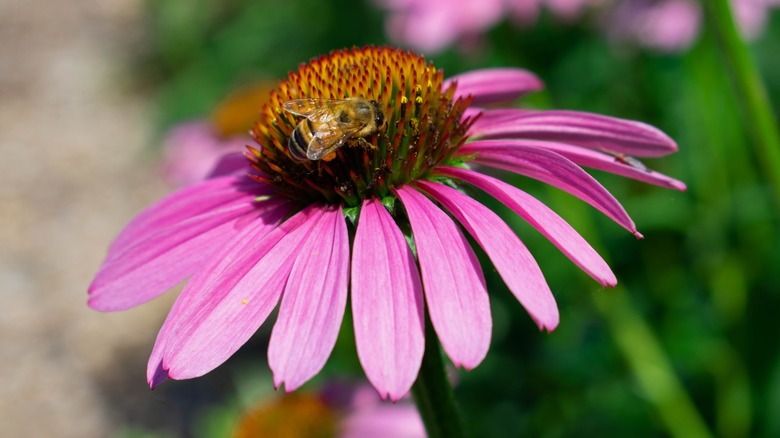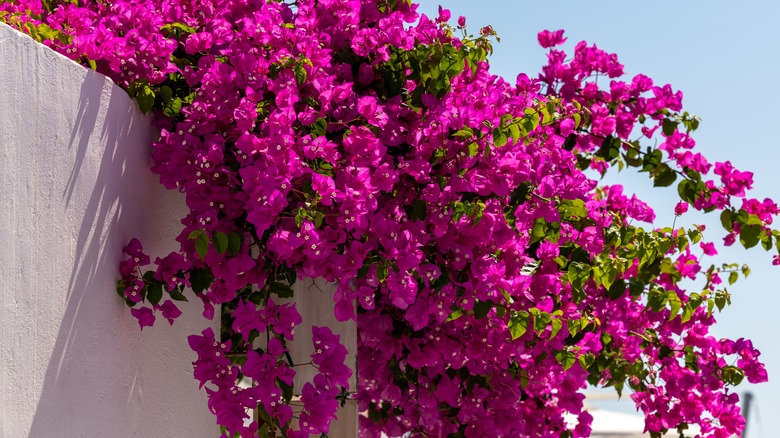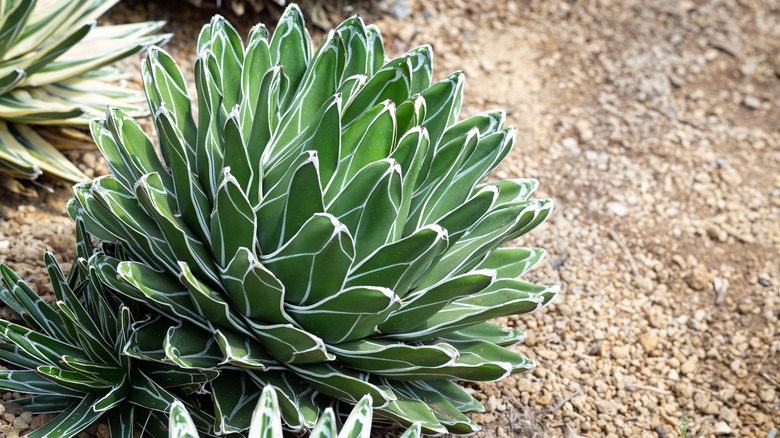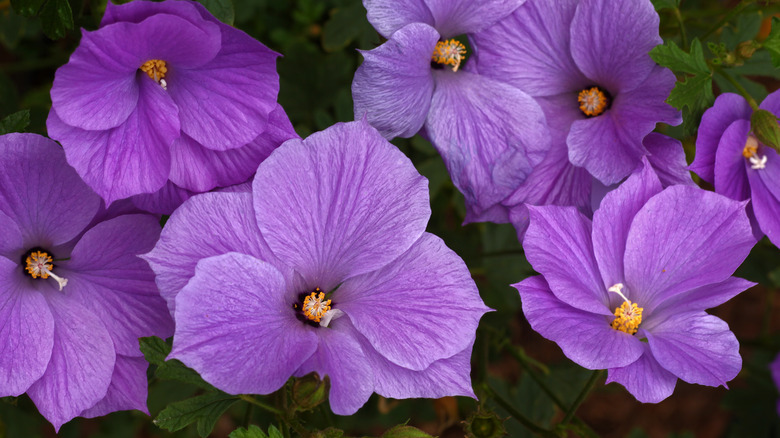The Best Outdoor Plants If You Live In A Dry Climate
Growing plants in a dry climate can challenge even the most experienced gardeners. Success, or lack thereof, can all come down to water. Too much or too little can equally cause problems and lead to stunted growth, infestations, and even plant death.
Dry conditions and drought affect a wide swath of the United States. This is most widely seen in the western and southwestern parts of the country. But big stretches of land in the Midwest and some pockets in the southeast also experience this, according to the U.S. Drought Monitor, a web tool run by the University of Nebraska–Lincoln.
If you live in an area that is frequently in drought or prone to dry climate conditions, there are many proactive steps you can take to ensure the health — and curb appeal — of both your plants and the surrounding environment. Though using mulch and enriching the soil with rich compost are great ideas, water-wise gardening is critical (via Los Angeles County's Department of Public Works). This is in part due to water supply shortages and extreme droughts spurred on by climate change.
One way to maximize your water-wise gardening is to pick plants that are best suited for growing in dry climates. From grasses and brightly flowering bushy shrubs to herbs that provide color and health benefits, there are so many unique and beautiful plants that thrive in drier areas. To help you narrow it down, here are 10 of the best outdoor plants if you live in a dry climate.
Salvias add pollinator-friendly pops of color
Salvias can be found in a wide variety of strong, rich colors, everything from intense purples and blues to deep reds and vibrant shades of pink. This makes them a great choice if you're looking to add eye-catching visual interest to your yard or garden space. As GardenersWorld.com points out, the uniquely shaped blooms are also full of nectar. If you've got salvia in your yard, hungry pollinators like bees, butterflies, and certain insects will be flocking to the plants.
Adding to the upsides of salvia is that once they're settled into your garden, they are drought-tolerant and don't require a lot of work (via Summer Winds Nursery). They are also "droop-proof." Given their size and shape, salvias make great additions to borders and container arrangements. These easy-to-grow blooms last throughout the season, providing curb appeal and attracting fluttering hummingbirds.
Well-draining soil is critical for salvias to grow their best. The soil should also not be too compacted. To keep your colorful salvia blooming for as long and as frequently as possible, remove dead flowers from the plant, which will encourage repeat blooming.
A low grass like fescue gives the illusion of a fully green yard
As reported by PBS in 2022, many Americans are opting against green grass as the major feature of a yard. Traditional green grass is very water-hungry. A water-wise yard or garden is especially important if you live in an area with a dry climate or one that is prone to experiencing frequent periods of drought. To still get that green-covered lawn look, however, while also being mindful of water usage and dry conditions, low grass-like fescue is a fantastic option.
Fescue grasses come in varieties like tall fescue, hard fescue, and fine fescue. Ideal for your hot-climate garden, they are not only drought-tolerant but also shade-tolerant (via North Dakota State University). And they maintain their green color all year round, so you'll be guaranteed a verdant yard space or garden no matter the season. Among the different grass species that there are, some only do well in cooler climates, while others benefit from warmer areas. Because they're able to prosper in places where other grasses don't grow so well, fescues can "fill in this gap in growing conditions."
A "cool-season" grass-like fine leaf fescue, as detailed by the University of California's Master Gardener Program of Contra Costa County, is great because it only requires 85 percent of the water a regular lawn would need in the summertime. It can also go with even less water. Another bonus to the water-saving advantages of a nontraditional grass lawn? No more mowing!
Rosemary makes for a great border and comes in handy in the kitchen
Rosemary, that staple kitchen herb, can serve a range of unique functions in your drought-tolerant yard or garden. Hailing from the warm Mediterranean region, the perennial rosemary grows as a shrub to a little over three feet in height (via Britannica). Though some can grow taller, the boxy, shrub-like nature of the herb means it can be easily shaped into a natural border or "fence" for your porch or other such space. Rosemary can grow densely, providing that border-like coverage.
Rosemary also produces small but brightly violet-colored flowers, which pop against the dark green color of its fragrant leaves. These leaves can be used in the kitchen too, to flavor all kinds of dishes. There are enticing health benefits as well. Rich in phytochemicals, which help fight diseases, rosemary has carnosic acid in it, which has been shown to slow cancer cell growth in some studies (per WebMD). Stress reduction is another benefit, as is better memory and concentration.
When giving your plants a solid start, keep in mind that your early watering habits are important, even with drought-resistant plants (via Los Angeles Times). When you water deeply, you encourage roots to grow deeper into the soil. There, root systems are more protected from extreme heat and can better access underground sources of moisture. Then, after about six months of getting established, they'll be prepared for less frequent watering.
Pollinators love lavender — and so will your drought-tolerant garden
From fragrant drawer sachets and bath soaks to soaps and sleep aids, one of the most common herbal additives is lavender. Its name even, as noted by the UC's Master Gardener Newspaper, is derived from the Latin word "lavare," which means "to bathe." This hugely popular and multifunctional herb can also be used in many teas and other consumables to boost your digestion, promote feelings of calm and improve blood circulation, among other health benefits.
In addition to its many personal care applications, lavender is a fabulous, drought-tolerant plant. It thrives in full sun and does not do well in wet conditions or in soil that does not drain well. And, on top of all its uses, blooming lavender, with its distinctive purple flowers, is a favorite of bees. The most popular lavender variety is L. Angustifolia, which is more commonly known as English lavender (via Missouri Botanical Garden), though the herb hails from the Mediterranean. This plant is a favorite of bees and other nectar lovers. Lavender has a seemingly endless blooming cycle, meaning that these pollinators can visit whenever they're hungry (via United States Lavender Growers Association). With any blooming, pollinator-friendly plant, it's best not to use pesticides or chemicals on them, as bees can transfer these deadly substances back to their hives.
Bushy lantana comes in a variety of vibrant, bright colors
The eye-catching colors of lantana plants can be spotted from far away. Reds, yellows, oranges, purples, even multiple colors in each bloom — with lantana, your yard or garden is sure to be a vibrant spot. As highlighted by McLendon Hardware, lantana is a drought-tolerant plant that blooms even in very hot conditions. Making them an even more enticing option, lantana's ball-shaped flowers maintain their bright colors throughout their life cycle, meaning you'll have consistent color month after month. Despite their colorful beauty, it's important to remember that lantana should be handled with care. Gloves are advised, as their foliage can cause skin irritation.
As a heat-friendly plant that does well in dry climates, lantana is prized for being tough, according to San Marcos Growers. The way it grows, both low and sprawling also means it can fill up large chunks of space, while its flowers deliver a strong visual impact at the same time. Though it does great in full sun, lantana also can thrive in a light shade area. Wherever you place it, the colorful flowers of a lantana plant will prove irresistible to pollinators like butterflies and bees. And arranging a handful of different-colored varieties near each other will give you a glowing, rainbow-like effect in your yard or garden.
A great groundcover, ice plants also provide wild pops of color
Ice plants are anything but frosty. This low-growing groundcover, whose scientific name is delosperma, originated in South Africa. As pointed out by Kellogg Garden Products, perennial ice plants love heat, do best in full sun, and grow fast. They also produce nearly neon flowers in hues like hot pink, red, and yellow, giving the plant a wildly colorful, carpet-like appearance. Even more enticing for the drought-tolerant garden, ice plants do great without a ton of care.
Ice plants got their unique nickname from the "sparkling evergreen foliage" of their leaves, as noted by High Country Gardens. They grow well over gravel, and, as an added bonus, their nectar and pollen are great for honeybees. They love well-drained soil and you only need to water them every 7 to 10 days when there hasn't been any rain. This will give your ice plants the best odds of producing an abundance of flowers and maintaining full foliage. At the end of the growing season, you should also cut back on watering to slightly dry out the plants and prepare them to withstand of cold of the winter months.
Coneflowers are loved by bees and butterflies
Coneflowers have a very cheery look and, for many reasons, are a great choice for any drought-tolerant garden or a gardener looking to attract birds and other pollinators to a space. According to Almanac, they get their name from their distinctive, cone-shaped center, and are perennials that originated in the United States. They will grow excellently in full sun in soil that drains well. They are especially great at self-seeding and spreading, which will mean less work for the busy gardener interested in a yard full of pops of color. Hybrid varieties, though, do not self-sow well.
Coneflowers can attract winged and feathered friends to your garden year-round (via Birds & Blooms). Butterflies will flock to your garden to visit the colorful blooms in spring and birds will love snacking on the seeds all summer. As the flowers die off at the end of the season, you might be attempted to deadhead them. However, leaving the dried-up seed pods gives birds a place to eat as fall and winter's cold temperatures take hold.
Bougainvillea will give you climbing color and SoCal vibes
When you think of Santa Barbara, you're probably thinking of its chic coastal-California style. The vibrantly colored bougainvillea plants are a big part of that, as they vine over many a Spanish tile roof or side wall in the town often called the American Riviera. These iconic climbing plants thrive not only in Santa Barbara but in any generally hot and dry environment.
According to NC State Extension Gardener, bougainvilleas are drought-tolerant after they're established. And surprisingly, it's not the flowers that give a bougainvillea its signature color, whether pink, red, orange, yellow, or even white. It's actually the foliage. The plant's "bracts, or modified leaves," are what are visible in so many different, rich hues.
Like with other drought-tolerant plants, incorporating them into your yard or garden is not only a matter of digging holes in the ground and setting them in. With bougainvilleas, because they have "fragile roots," they need to be kept moist in an evenly distributed way after you first plant them (via Santa Barbara Independent). Once they're established in your yard, watering can be greatly reduced.
For a sculptural, southwestern look, go for agave
For margarita fans, agave is well known. The blue variety is the pointy succulent plant used to make mezcal. But according to UC Davis, agave is much more than just a beverage ingredient. The university notes that the plant is perfect for growing in areas that experience frequent drought conditions. And perfect for water-wise gardeners, it needs very little watering.
With their cactus-like shapes, agave plants will add a striking, sculptural look to your drought-tolerant yard or garden. And also thanks to their unique appearance, they'll impart a southwestern, desert-style ambiance at the same time. The hardy shape and structure of agave is actually an evolutionary byproduct of where they developed (via Scientific American).
An agave's unique type of photosynthesis, known as crassulacean acid metabolism, enables it to grow in semiarid climates with little water. In addition to agaves, plants including pineapples, prickly pears, and vanilla orchids also engage in crassulacean acid metabolism. Scientists think that agaves may hold the key to developing more plants that can survive and thrive in drought conditions. In the meantime, whether you grow it as a houseplant or outside, be sure to investigate the variety you choose. Some agaves, like the century plant, or Agave americana, can reach up to 15 feet in height (via MasterClass)!
With its vivid flowers, the low-maintenance blue hibiscus is great for beginners
An easy-to-maintain shrub that produces vividly blue flowers and grows well in drought-like conditions? It might sound too good to be true! But, blue hibiscus shrubs do well in full sun, can be grown in containers, and require low to moderate amounts of water after they are established, according to Moon Valley Nurseries. And don't let the name "hibiscus" fool you. These shrubs, sometimes also called lilac hibiscus, are actually not members of the traditional hibiscus family! They're native to Western Australia, where they grow along the coastline, but in the United States, they can be grown as an evergreen plant.
The brilliantly blue flowers of a blue hibiscus get very big, up to four to five inches in diameter (via Annie's Annuals & Perennials). The shrub itself can grow to be six feet by eight feet in size but responds well to trimming and pruning, which will actually cause the blue hibiscus to flower even more than when it's left to its own devices. For an even more unique look, try trimming your blue hibiscus into the shape of a tree to give it the illusion of a true hibiscus tree. As far as soil requirements for this great-for-beginners flowering shrub, soil that drains well is most important. Whether the soil is rich or poor, or even sandy, the blue hibiscus will thrive with little water after it's established.
